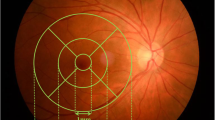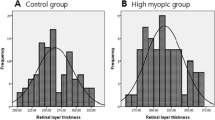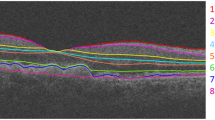Abstract
Purpose
To compare intraretinal layers between the eyes in patients with myopic anisometropia, and evaluate the relationship between the layers with spherical equivalent (SE) and axial length (AL).
Methods
In this retrospective study, the more myopic (MM) and fellow (F) eyes of 41 patients with myopic anisometropia, and 38 emmetropic (± 0.50 diopter) control (C) eyes were inclueded. Intraretinal layer segmentation was performed by optical coherence tomography. Global volumes of retinal layers and their thicknesses in nine macular regions were compared. Correlation analysis was used to determine the relationship with SE and AL in each layer.
Results
Total retinal, ganglion cell (GCL), inner nuclear (INL), and outer plexiform (OPL) layer volumes in MM eyes were less than in C eyes, while INL and OPL were less than in F eyes. There was no difference in the fovea, except for the retinal pigment epithelium. In MM eyes, only INL and OPL were thin in at least one perifoveal and parafoveal quadrant compared to F eyes. Only INL and OPL thicknesses were significantly correlated with both SE and AL in all perifoveal quadrants. In contrast to the thinning found in MM eyes, the only layer in which thickening was detected to compare to C eye was nerve fiber layer (NFL), which correlated positively with SE and negatively with AL.
Conclusion
While the fovea is less affected by myopia, thinning becomes remarkable in the perifoveal quadrants. Despite thinning in many layers, especially INL and OPL, NFL thickening may be seen due to myopia.



Similar content being viewed by others
References
Holden BA, Fricke TR, Wilson DA, Jong M, Naidoo KS, Sankaridurg P, Wong TY, Naduvilath TJ, Resnikoff S (2016) Global prevalence of myopia and high myopia and temporal trends from 2000 through 2050. Ophthalmology 123(5):1036–1042. https://doi.org/10.1016/j.ophtha.2016.01.006
Liu X, Shen M, Yuan Y, Huang S, Zhu D, Ma Q, Ye X, Lu F (2015) Macular thickness profiles of intraretinal layers in myopia evaluated by ultrahigh-resolution optical coherence tomography. Am J Ophthalmol 160(1):53–61
Pugazhendhi S, Ambati B, Hunter AA (2020) Pathogenesis and prevention of worsening axial elongation in pathological myopia. Clin Ophthalmol (Auckland, NZ) 14:853–873. https://doi.org/10.2147/OPTH.S241435
Vincent SJ, Collins MJ, Read SA, Carney LG (2014) Myopic anisometropia: ocular characteristics and aetiological considerations. Clin Exp Optom 97(4):291–307
Bazzazi N, Akbarzadeh S, Yavarikia M, Poorolajal J, Fouladi DF (2017) High myopia and diabetic retinopathy: a contralateral eye study in diabetic patients with high myopic anisometropia. Retina 37(7):1270–1276
Eliwa TF, Hussein MA, Zaki MA, Raslan OA (2018) Outer retinal layer thickness as good visual predictor in patients with diabetic macular edema. Retina 38(4):805–811
Nittala MG, Hogg RE, Luo Y, Velaga SB, Silva R, Alves D, Staurenghi G, Chakravarthy U, Sadda SR (2019) Changes in retinal layer thickness in the contralateral eye of patients with unilateral neovascular age-related macular degeneration. Ophthalmol Retina 3(2):112–121
Pazos M, Dyrda AA, Biarnés M, Gómez A, Martín C, Mora C, Fatti G, Antón A (2017) Diagnostic accuracy of Spectralis SD OCT automated macular layers segmentation to discriminate normal from early glaucomatous eyes. Ophthalmology 124(8):1218–1228
Kim JH, Lee SH, Han JY, Kang HG, Byeon SH, Kim SS, Koh HJ, Lee SC, Kim M (2019) Comparison of individual retinal layer thicknesses between highly myopic eyes and normal control eyes using retinal layer segmentation analysis. Sci Rep 9(1):1–11
Venkatesh R, Sinha S, Gangadharaiah D, Gadde SG, Mohan A, Shetty R, Yadav NK (2019) Retinal structural-vascular-functional relationship using optical coherence tomography and optical coherence tomography–angiography in myopia. Eye Vision 6(1):8
Ruiz-Medrano J, Montero JA, Flores-Moreno I, Arias L, García-Layana A, Ruiz-Moreno JM (2019) Myopic maculopathy: current status and proposal for a new classification and grading system (ATN). Prog Retin Eye Res 69:80–115
Grading diabetic retinopathy from stereoscopic color fundus photographs--an extension of the modified Airlie House classification. ETDRS report number 10. Early Treatment Diabetic Retinopathy Study Research Group (1991). Ophthalmology 98 (5 Suppl):786–806
Lam DSC, Leung KS, Mohamed S, Chan W-m, Palanivelu MS, Cheung CYL, Li EYM, Lai RYK, Leung CK-S (2007) Regional variations in the relationship between macular thickness measurements and myopia. Invest Ophthalmol Vis Sci 48(1):376–382
Schober P, Boer C, Schwarte LA (2018) Correlation coefficients: appropriate use and interpretation. Anesth Analg 126(5):1763–1768
Abbott CJ, Grünert U, Pianta MJ, McBrien NA (2011) Retinal thinning in tree shrews with induced high myopia: optical coherence tomography and histological assessment. Vision Res 51(3):376–385
Wu P, Chen Y, Chen C, Chen Y, Shin S, Yang H, Kuo H (2008) Assessment of macular retinal thickness and volume in normal eyes and highly myopic eyes with third-generation optical coherence tomography. Eye 22(4):551–555
Lee MW, Nam KY, Park HJ, Lim H-B, Kim J-Y (2020) Longitudinal changes in the ganglion cell-inner plexiform layer thickness in high myopia: a prospective observational study. Br J Ophthalmol 104(5):604–609
Müller B, Joussen A (2011) Myopic traction maculopathy-vitreoretinal traction syndrome in high myopic eyes and posterior staphyloma. Klin Monbl Augenheilkd 228(9):771–779
Ehrlich D, Sattayasai J, Zappia J, Barrington M (1990) Effects of selective neurotoxins on eye growth in the young chick. In: Bock GR (organizer), Widdows K (ed) Myopia and the control of eye growth, vol 155. Wiley Chichester, pp 63–68
Mao J, Liu S, Wen D, Tan X, Fu C (2006) Basic fibroblast growth factor suppresses retinal neuronal apoptosis in form-deprivation myopia in chicks. Curr Eye Res 31(11):983–987
McBrien N, Jobling A, Truong H, Cottriall C, Gentle A (2009) Expression of muscarinic receptor subtypes in tree shrew ocular tissues and their regulation during the development of myopia. Mol Vis 15:464
Mathis U, Feldkaemper M, Wang M, Schaeffel F (2020) Studies on retinal mechanisms possibly related to myopia inhibition by atropine in the chicken. Graefes Arch Clin Exp Ophthalmol 258(2):319–333
Ye J, Shen M, Huang S, Fan Y, Yao A, Pan C, Shi X, Lu F, Shao Y (2019) Visual Acuity in Pathological Myopia Is Correlated With the Photoreceptor Myoid and Ellipsoid Zone Thickness and Affected by Choroid Thickness. Invest Ophthalmol Vis Sci 60(5):1714–1723. https://doi.org/10.1167/iovs.18-26086
Lai TYY, Cheung CMG (2016) MYOPIC CHOROIDAL NEOVASCULARIZATION: diagnosis and treatment. Retina 36(9):1614–1621. https://doi.org/10.1097/iae.0000000000001227
Spector RH (1990) clinical methods: the history, physical, and laboratory examinations. visual fields, 3rd edn. Butterworths, Boston
Bennett AG, Rudnicka AR, Edgar DF (1994) Improvements on Littmann’s method of determining the size of retinal features by fundus photography. Graefes Arch Clin Exp Ophthalmol 232(6):361–367. https://doi.org/10.1007/bf00175988
Littmann H (1982) Determination of the real size of an object on the fundus of the living eye. Klin Monbl Augenheilkd 180(4):286–289. https://doi.org/10.1055/s-2008-1055068
Ctori I, Huntjens B (2015) Repeatability of foveal measurements using spectralis optical coherence tomography segmentation software. PLoS ONE 10(6):e0129005. https://doi.org/10.1371/journal.pone.0129005
Ctori I, Gruppetta S, Huntjens B (2015) The effects of ocular magnification on Spectralis spectral domain optical coherence tomography scan length. Graefes Arch Clin Exp Ophthalmol 253(5):733–738. https://doi.org/10.1007/s00417-014-2915-9
Zhang Z, He X, Zhu J, Jiang K, Zheng W, Ke B (2011) Macular measurements using optical coherence tomography in healthy Chinese school age children. Invest Ophthalmol Vis Sci 52(9):6377–6383
Garcia-Martin E, Polo V, Larrosa JM, Marques ML, Herrero R, Martin J, Ara JR, Fernandez J, Pablo LE (2014) Retinal layer segmentation in patients with multiple sclerosis using spectral domain optical coherence tomography. Ophthalmology 121(2):573–579. https://doi.org/10.1016/j.ophtha.2013.09.035
Kim JH, Lee MW, Byeon SH, Kim SS, Koh HJ, Lee SC, Kim M (2018) Associations between individual retinal layer thicknesses and diabetic peripheral neuropathy using retinal layer segmentation analysis. Retina 38(11):2190–2196. https://doi.org/10.1097/iae.0000000000001835
Brandl C, Brücklmayer C, Günther F, Zimmermann ME, Küchenhoff H, Helbig H, Weber BHF, Heid IM, Stark KJ (2019) Retinal layer thicknesses in early age-related macular degeneration: results from the German AugUR study. Invest Ophthalmol Vis Sci 60(5):1581–1594. https://doi.org/10.1167/iovs.18-25332
Funding
This research received no specific grant from any funding agency in the public, commercial, or not-for-profit sectors.
Author information
Authors and Affiliations
Contributions
Furkan Kirik and Hakan Ozdemir were involved in conceptualization; Furkan Kirik and Hakan Ozdemir helped in methodology; Ersin Akbulut and Furkan Kirik contributed to formal analysis and investigation; Furkan Kirik, Cansu Ekinci, and Havvanur Bayraktar were involved in writing—original draft preparation; Furkan Kirik helped in writing—review and editing; Hakan Ozdemir helped in supervision.
Corresponding author
Ethics declarations
Conflict of interest
The authors declare that they have no conflict of interest.
Ethical approval
This study was performed in line with the principles of the Declaration of Helsinki. Approval was granted by the Ethics Committee of Bezmialem Vakif University.
Informed consent
Informed consent was obtained from all individual participants or their parents/legal guardians.
Additional information
Publisher's Note
Springer Nature remains neutral with regard to jurisdictional claims in published maps and institutional affiliations.
Supplementary Information
Below is the link to the electronic supplementary material.
Rights and permissions
About this article
Cite this article
Kirik, F., Ekinci, C., Akbulut, E. et al. Regional analysis of segmented-macular structure in patients with myopic anisometropia. Int Ophthalmol 41, 3713–3726 (2021). https://doi.org/10.1007/s10792-021-01934-7
Received:
Accepted:
Published:
Issue Date:
DOI: https://doi.org/10.1007/s10792-021-01934-7




